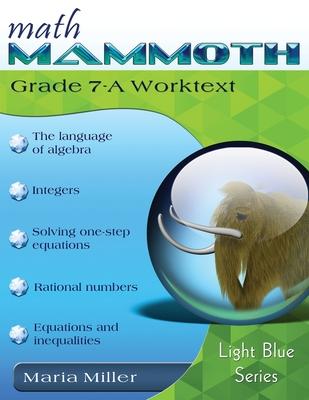This book has gray-scale interior pages.
Math Mammoth Grade 7-A is the student worktext for the first half of grade 7 mathematics studies, as part of Math Mammoth Grade 7 curriculum.
The curriculum meets and exceeds the Common Core Standards (CCS) for grade 7. It exceeds them because we study linear equations in more depth than required in grade 7 CCS.
We start out with an introduction to basic algebra, which is in many ways a review of the same topics from 6th grade. The first chapter reviews the order of operations, the concepts of an expression and equation, and the distributive property. Students learn about the commutative and associative properties of addition and multiplication, and they simplify expressions that don't involve negative numbers.
In chapter 2, we study integers and their operations in detail. Again, some of this is review from 6th grade, and some of it is new. The four operations of integers are explained with the help of two visual models: the number-line and counters, hopefully providing an intuitive understanding of the processes. Students need to be able to add, subtract, multiply, and divide integers when they learn to solve equations in chapter 3. In the end of the chapter, students also learn about negative fractions.
The lesson about distance contains a formula that may look unfamiliar to the teacher. You can find the distance between two integers by taking the absolute value of their difference. In symbols, the distance between a and b is a - b . The idea behind the formula is simple, though, and most people use that idea instinctively without knowing about the formula. For example, how far apart from each other are 14 and 92? To solve that mentally, we find their difference, but we take that difference in a positive sense. In other words, we do not calculate 14 - 92 = -78 and state that the distance is negative 78 units, but instead, we say the distance is 78 units because distance is always positive. The absolute value takes care of that: it turns any negative quantity into a positive one.
In the next chapter (chapter 3) students study simple one-step equations. They already know the basics of how to solve this type of equations from 6th grade, but this time we use negative numbers in them.
Chapter 4 is titled Rational Numbers, which are simply fractions and certain decimals, so the student is already very familiar with them. The goal of the chapter is to be able to add, subtract, multiply, and divide both positive and negative fractions and decimals. We also solve simple equations involving fractions and decimals and learn about scientific notation and complex fractions.
The last chapter in part 7-A focuses on linear equations. The student learns to solve various types of linear equations and practices using those in simple word problems. We study linear inequalities but not to the same depth as linear equations. Lastly, the student graphs linear equations and is introduced to the concept of slope, which is the steepness of a line. The student will continue studying these topics with more details in an Algebra 1 Course.
